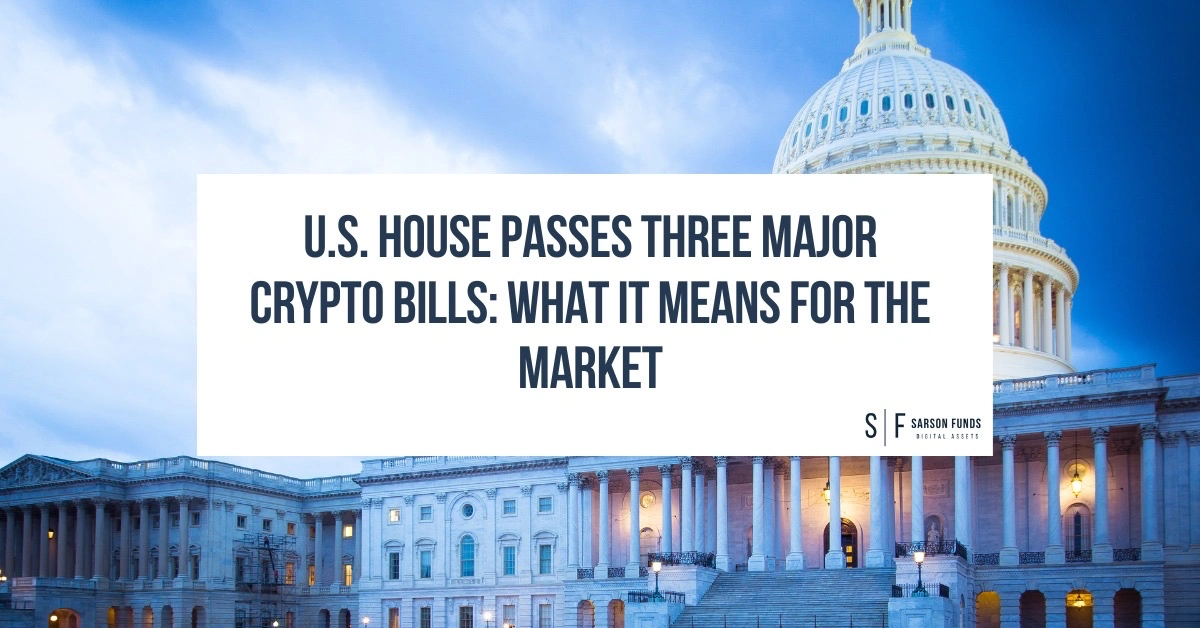
In a legislative push informally dubbed “Crypto Week,” the U.S. House of Representatives passed three high-impact digital asset bills that signal a turning point in how the crypto market may be regulated moving forward. Now awaiting Senate action, these bills aim to bring regulatory clarity and institutional legitimacy to stablecoins, crypto markets, and central bank digital currencies. The news coincided with a broader crypto rally, which added more than $150 billion in market value over the past week.
The Legislation at a Glance
-
- GENIUS Act (Guiding and Establishing National Innovation for U.S. Stablecoins Act)
This bipartisan legislation establishes a formal regulatory framework for payment stablecoins. It requires issuers to:- Hold 1:1 reserves in cash or U.S. Treasury
- Undergo monthly audits and disclosures
- Register with both federal and state regulators, including banks and non-bank issuers
- Already passed by the Senate and sent to the President’s desk on July 18, 2025, the GENIUS Act represents a major milestone in legitimizing stablecoins as a payment tool.
- CLARITY Act (Digital Asset Market Clarity Act)
The CLARITY Act resolves long-standing jurisdictional ambiguities by:- Defining which digital assets fall under SEC vs. CFTC oversight
- Clarifying compliance, registration, and disclosure requirements
- Establishing a clearer framework for asset issuance and trading
- Anti-CBDC Surveillance State Act
This narrowly passed bill (219–210) bars the Federal Reserve from issuing a central bank digital currency (CBDC) without explicit congressional approval. The aim is to prevent potential overreach in programmable money and preserve individual financial privacy.
- GENIUS Act (Guiding and Establishing National Innovation for U.S. Stablecoins Act)
Market and Industry Impacts
-
- Regulatory Clarity for Institutions
Defining regulatory responsibilities across the SEC and CFTC—along with stablecoin standards—helps reduce legal gray areas that have deterred banks and large firms from entering the space. - Stablecoins Gain Institutional Traction
Stablecoins backed by reserves and subject to regular audits will now be seen as more secure, regulated alternatives—clearing a path for greater use in everyday transactions and enterprise payment rails. - CBDC Restrictions Reinforce Privacy Advocacy
The Anti-CBDC bill aims to ensure that future CBDC proposals protect against government surveillance and remain accountable to the legislative process. - Positive Market Sentiment
Crypto markets responded favorably during the week. Bitcoin briefly surged past $120K late Sunday before reaching a new all-time high just below $123K, though it retraced to below $118K by Friday. Ethereum climbed 7.6% Friday to an intraday high of $3,675.60—the highest since January—capping a 19% gain over seven days. XRP led altcoin gains at 22.8%, with notable upticks in Dogecoin (11.4%), Solana (8.5%), Tron (7.7%), and Binance’s BNB (5.8%). Coinbase shares rose 6% to over $444. Altogether, the total crypto market cap added approximately $150 billion over the week, rising from $3.78 trillion to $3.93 trillion, according to CoinGecko. - Corporate and Fintech Momentum
Major firms including Circle, Coinbase, Walmart, and Amazon have expressed renewed interest in digital asset initiatives, particularly around stablecoin applications and integrated payments.
- Regulatory Clarity for Institutions
Why These Bills Matter
| Benefit | Description |
|---|---|
| Trust & Safety | Compliance standards offer protection for consumers and investors |
| Faster Innovation | Reduces legal uncertainty for builders and startups |
| Global Positioning | Helps the U.S. reclaim leadership in the digital finance and Web3 economy |
| Privacy Protection | Ensures CBDC development remains accountable and aligned with civil liberties |
The Crypto Council for Innovation called the GENIUS Act a “watershed moment,” and praised the CLARITY Act for turning years of regulatory opacity into investor confidence.
The Takeaway
Together, the GENIUS Act, CLARITY Act, and Anti-CBDC Act represent a foundational shift from regulatory ambiguity to structured oversight in U.S. digital asset policy. While the road ahead will depend on Senate follow-through and implementation details, the direction is now clear: the digital asset economy is being brought into the regulatory mainstream.
For investors, institutions, and builders, this marks the beginning of a more mature phase for crypto in the U.S. It is a phase where rules are being written, and where innovation can proceed with greater legal certainty and fewer unknowns.
Disclosure: This article is for informational purposes only and should not be considered financial, legal, tax, or investment advice. It provides general information on cryptocurrency without accounting for individual circumstances. Sarson Funds, Inc. does not offer legal, tax, or accounting advice. Readers should consult qualified professionals before making any financial decisions. Cryptocurrency investments are volatile and carry significant risk, including potential loss of principal. Past performance is not indicative of future results. The views expressed are those of the author and do not necessarily reflect those of Sarson Funds, Inc. By using this information, you agree that Sarson Funds, Inc. is not liable for any losses or damages resulting from its use.









